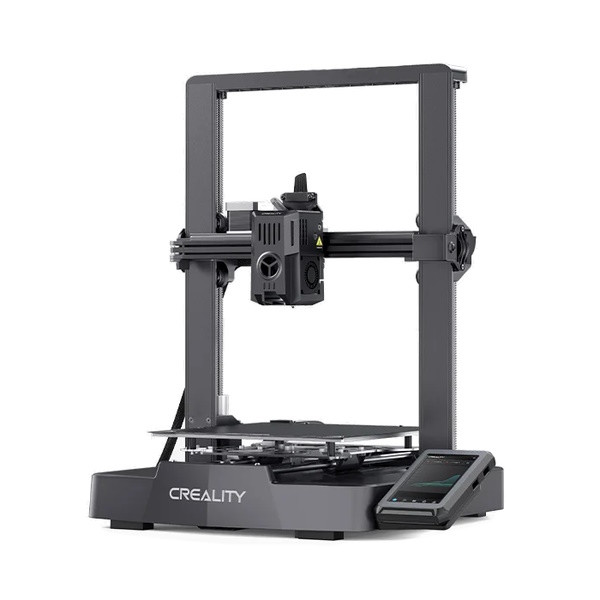 |
|
|
Menu
My 123-3D.co.uk
Creality 3D Ender 3 V3 KE 3D Printer Review
Creality 3D Ender 3 V3 KE: An In-Depth Review
We’re taking a closer look at the Creality Ender 3 V3. This 3D printer is a direct follow-up to the popular Ender 3 V3 SE model, and we’ll be diving into every aspect of the machine, from its build quality to its performance, to help you determine if it’s the right choice for your 3D printing needs. The Ender 3 V3 has undergone rigorous testing, and it has consistently delivered impressive print quality. Even when printing at high speeds, the machine shows no signs of common issues such as ringing, ghosting, or other print artifacts. The overall quality of the prints is exceptional, and the machine’s reliability makes it a strong contender in its price range.
Skip ahead to our Final Thoughts.
Overview of the Ender 3 V3
The Creality Ender 3 V3 is designed with both new and experienced users in mind. It offers a build volume of 220mm x 220mm x 240mm, which is quite sufficient for most standard printing tasks. This size is particularly beneficial for those who are comfortable printing multiple parts or slicing larger models to assemble later. The machine operates on Creality OS, which is essentially a customized version of Klipper. Creality has streamlined Klipper’s functionality to make it more user-friendly while still allowing advanced users the option to unlock additional features through root access.
The Ender 3 V3 can achieve a typical print speed of up to 300mm per second. While it can reach this speed, it’s important to note that the machine’s bed-slinging mechanism might cause some wobble, especially with taller prints. Therefore, while the machine can handle rapid speeds, it’s best to reserve these for shorter or less intricate prints to maintain the highest quality. The machine supports standard 1.75mm filament and comes pre-equipped with a 0.4mm nozzle. It also includes a filament runout sensor as standard, which is a thoughtful addition that helps prevent failed prints when filament runs low.
Another key feature is the machine’s textured PEI build plate, which can reach temperatures of up to 100°C, making it suitable for a wide range of materials including PLA, PETG, TPU, ABS, and ASA. The nozzle itself can heat up to 300°C, further expanding the range of compatible materials. The 4.3-inch touchscreen provides a smooth and responsive interface, enhancing the overall user experience.
Design and Build Quality
When it comes to design and build quality, the Ender 3 V3 shares many similarities with the Ender 3 V3 SE model. Creality has made some cost-saving decisions, such as using a plastic base for the machine. However, this plastic base should not be seen as a drawback. Inside, the plastic houses a robust aluminium brace that spans the entire structure, effectively holding the metal components together and providing a solid, rigid frame. The plastic mainly serves as a protective shell and helps reduce the need for additional aluminium extrusions, which are typically more expensive.
The machine’s bed moves on smooth rails, with bearings fixed to the bottom, allowing for free and stable movement in both directions. The rails are spaced far apart, contributing to a more stable build platform. The bed is driven by a belt, powered by a stepper motor located underneath the base. This setup ensures simple and efficient movement, and the belt tension can be easily adjusted by turning a small Allen screw at the back.
Creality has equipped the Ender 3 V3 with a flexible magnetic build plate, a significant upgrade from the glass plates used on older models. The build plate is made from spring steel and features a textured PEI surface, which helps with adhesion during printing and makes removing prints easier. The plate aligns securely with two location screws on the magnetic base, ensuring it stays in place during the printing process.
One of the highlights of the machine is the direct-drive extruder, known as the Sprite Extruder. This extruder is a refined version of its predecessor, now featuring a plastic cover that hides the internal components, giving it a more compact and visually appealing design. The direct-drive system pulls the filament directly into the hot end, providing more accurate and faster filament feeding compared to the older Bowden system, which pushed the filament through a tube. This setup eliminates the need to worry about V-wheels wearing out since the machine relies on a belt-driven system, which is easy to maintain with periodic tension adjustments.
The machine uses a single stepper motor to drive the lead screw, which is synchronized with the Y-axis belt to provide smooth and consistent motion. The CR Touch probe, which assists with bed levelling, is now located at the back of the machine, a shift from previous models where it was mounted on the side of the extruder. This new placement helps streamline the machine’s design.
One of the critical factors that enable this machine to print at high speeds is its dual fan cooling system. Effective cooling is essential for successful PLA printing, and the dual-fan system ensures that the model is cooled from both sides of the extruder, preventing the filament from melting, and deforming on the build plate. During testing, this cooling system proved to be highly efficient, even when printing models with significant overhangs.
Extrusion Design and Internal Features
The Ender 3 V3’s extrusion design has been enhanced with a T-shaped profile. This profile provides a wide, flat face that conceals the machine’s internal mechanics, while the V-wheels run smoothly along the grooves in the profile. The design maximizes surface area contact, reducing wear and tear over time. Unlike some other models that require frequent adjustments to keep the V-wheels running smoothly, the Ender 3 V3’s design keeps the wheels snug and stable, requiring minimal maintenance.
The front of the machine features a clean, streamlined profile, with the injection-moulded top brace being densely reinforced to prevent any flexing during operation. However, it’s worth noting that the machine might struggle to handle spools larger than 1.1kg due to potential movement issues. For those who use larger spools, a table-mounted filament holder might be necessary to ensure smooth operation.
The filament runout sensor is another valuable feature of the Ender 3 V3. This sensor automatically pauses the machine when the filament runs out, keeping the print bed at the correct temperature until more filament is loaded. This feature also comes in handy during power outages, as the machine can resume printing with minimal under-extrusion once power is restored. This capability is crucial for maintaining print quality, particularly during long or intricate prints.
Inside the machine, the components are organized. It comes with a 350W power supply, with all wiring secured and ferrule connectors used for connections to the mainboard. The plugs are additionally secured with hot glue to prevent them from coming loose during transit or while the machine is operating at high speeds. The stepper motor that drives the bed is also neatly tucked away inside the base, contributing to the machine’s clean internal design.
Assembly and Software
Assembling the Ender 3 V3 is a straightforward process. When the machine arrives, the main gantry is separate from the base, and the assembly requires just a few screws to secure everything in place. The screen mount attaches with three screws, and the screen itself clips on easily. After connecting the stepper motor cable, extruder cable, and filament spool holder, which comes with the filament runout sensor pre-attached, the machine is ready to be powered on. The on-screen instructions guide you through the initial setup, making it an effortless process even for beginners.
The machine’s firmware and user interface are designed with user convenience in mind. The 4.3-inch colour touchscreen is intuitive, allowing users to easily navigate through the machine’s settings, including Wi-Fi connectivity, system information, and even an option for a camera. The machine features two standard USB sockets on the side of the screen and one on the back, which suggests potential compatibility with future camera add-ons.
One of the significant advantages of the Ender 3 V3 is its ability to update firmware remotely via Wi-Fi, a feature that significantly improves the user experience compared to older models that required manual updates via SD cards. Once connected to Wi-Fi, the printer can download and install firmware updates with just a few clicks. However, it’s advisable to wait a few weeks after a firmware update is released to ensure stability before applying it. After updating, it is a clever idea to run a self-check to confirm everything is functioning correctly before starting a print.
For slicing software, beginners are encouraged to use Creality Print, the software provided with the machine. Creality has optimized this slicer to work seamlessly with their printers, making it an excellent starting point for those new to 3D printing. For more experienced users, the Ender 3 V3 also supports Orca Slicer, which now includes a default profile specifically for this machine. Creality OS, the firmware that powers the machine, is a trimmed-down version of Klipper. While it is simplified for ease of use, Creality has left root access available, allowing advanced users to connect the machine to Fluidd or Mainsail and unlock its full potential. However, this level of customization might be overwhelming for beginners.
Final Thoughts
In conclusion, the Creality Ender 3 V3 is a very capable 3D printer that has been thoughtfully designed and well-executed. It offers excellent value for its price, providing a premium feel and high performance that is accessible to both beginners and experienced users alike. While it has some limitations, such as potential wobble at higher print heights and the need for additional features through future updates, these are minor considerations compared to the overall strengths of the machine.
 |
Creality3D Creality 3D Ender 3 V3 KE 3D printer |
| Order now | |









